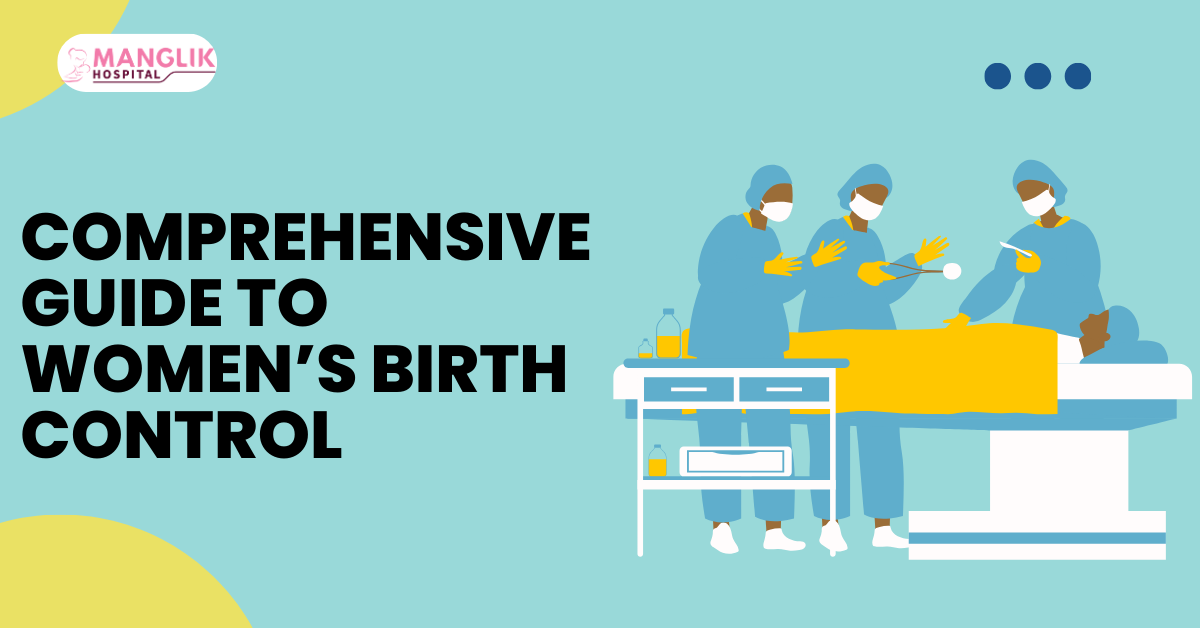
Introduction
Birth Control known as Contraception, describes techniques or instruments used to avoid getting pregnant. These techniques function by either stopping sperm from reaching an egg (fertilisation), stopping eggs from leaving the ovaries (ovulation).As women take charge of their reproductive health, the arrangement of birth control options available can be massive. This complete guide aims to empower women with knowledge about various birth control methods. Let’s allow them to make informed decisions that line up with their individual needs and goals.
Table of Contents
Understanding the Methods
Barrier Methods
a. Condoms: The oldest and most widely used form of contraception, condoms provide a physical barrier, preventing sperm from reaching the egg. They also offer protection against sexually transmitted infections (STIs).
b. Diaphragms and Cervical Caps: These devices block the cervix, preventing sperm from entering the uterus. They must be used with spermicide and fitted by a healthcare professional.
Hormonal Methods
a. Birth Control Pills: Oral contraceptives, recommended and prescribed by the best gynecologist in Lucknow, are a popular hormonal option. They contain synthetic hormones, usually a combination of estrogen and progestin, to check ovulation and alter cervical mucus, making it harder for sperm to reach the egg.
b. Patch: This sticky patch(white discharge) releases hormones through the skin to prevent pregnancy. It’s typically applied to the skin once a week.
c. Vaginal Ring: A flexible, hormonal ring is inserted into the vagina, releasing hormones that prevent ovulation and thicken cervical mucus while also giving essential hydration for the vagina.
d. Birth Control Shot: A hormonal injection, usually administered every three months, offers a longer-term contraceptive option.
e. Implant: A small, matchstick-sized rod is placed under the skin of the upper arm, releasing hormones to prevent pregnancy for up to three years.
Intrauterine Devices (IUDs)
a. Copper IUD: Non-hormonal and effective for up to 10 years, the copper IUD interferes with sperm function, preventing fertilization.
b. Hormonal IUD: Releases progestin to check ovulation and alter cervical mucus. It can last up to 3 to 6 years, depending on the type.
Permanent Methods
a. Tubal Ligation: A surgical procedure that permanently blocks or seals the fallopian tubes, preventing the egg from meeting sperm.
b. Hysterectomy: A surgical removal of the uterus, considered lasting and used as a last resort for it.
Factors to Consider: Birth Control
Health Considerations
It’s crucial to discuss health history with a healthcare professional to determine which method is safe and suitable. Smokers and women with certain health conditions may need to avoid hormonal methods due to increased risk factors.
Lifestyle and Preferences
Consider your daily routine, including managing white discharge reviews check-up your white discharge problems, remembering to take pills or schedule appointments for injections or patches. Some women prefer non-hormonal methods for personal or health reasons.
Long-Term vs. Short-Term Goals: Birth Control
If planning for a family is in the isolated future, long-acting methods like IUDs or implants may be more suitable. For those considering a family sooner, adaptable methods offer flexibility.
STI Protection
a. Barrier methods, such as condoms, provide dual protection against unwanted pregnancies and STIs.
Empowering Decision-Making

Consultation with Healthcare Providers
a. Regular check-ups with healthcare professionals ensure that the chosen method is effective and compatible with overall health.
b. Discuss concerns, side effects, and potential changes in contraceptive needs over time.
Educational Resources
a. Stay informed through reputable sources, understanding the mechanisms, effectiveness, and potential side effects of each method.
b. Online resources, community healthcare centres, and educational materials can provide valuable insights.
Conclusion
Navigating the world of birth control options is a personal journey that requires careful consideration of various factors. By understanding the wide range of choices available, considering individual health needs and preferences, and engaging in open communication with healthcare professionals to talk about menstrual health problems, women can confidently take charge of their reproductive health. This comprehensive guide aims to empower women to make informed decisions, fostering a sense of control and well-being in their contraceptive choices.
FAQS
1.What are the most common types of birth control methods available?
Ans: Common birth control methods include condoms, birth control pills, patches, vaginal rings, injections, implants, intrauterine devices (IUDs), and permanent methods like tubal ligation.
2.How do hormonal birth control methods work?
Ans: Hormonal methods, such as birth control pills, patches, and injections, release synthetic hormones to prevent ovulation and alter cervical mucus, making it more difficult for sperm to reach the egg.
3.Are there non-hormonal birth control options?
Ans: Yes, non-hormonal options include barrier methods like condoms, diaphragms, and cervical caps, as well as the copper IUD, which does not release hormones.
4.What is an IUD, and how does it work?
Ans: An intrauterine device (IUD) is a small, T-shaped device placed in the uterus. The copper IUD interferes with sperm function, while hormonal IUDs release progestin to prevent ovulation and alter cervical mucus.
5.How effective are birth control methods?
Ans: Effectiveness varies among methods. Hormonal methods and IUDs are highly effective when used correctly, while barrier methods may have a higher failure rate if not used consistently.
